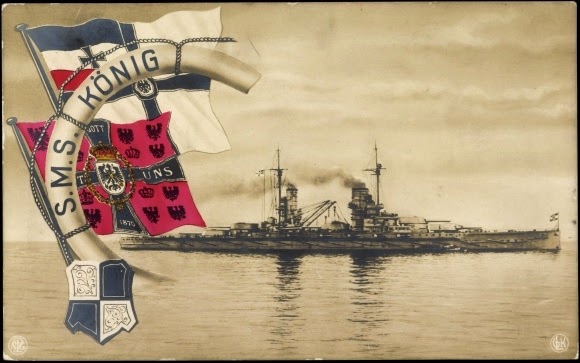The 84th Inf Reg "von Mannstein" from Schleswig advancing.
Miniatures from Great War Miniatures.
These are the two first squads of a four-base company.
Miniatures from Great War Miniatures.
These are the two first squads of a four-base company.
This week I refocused my imagination from the brisk waves on the North Sea and the Battle of Jutland 1916, to the dusty roads of Belgium and the summer heat of august 1914. It was finally time to get started with my Early World War One project.
As few of my regular readers have escaped, I grew up in Jutland. Again this coincides with my WW1 projects. This time, I wanted to focus on the 30.000 Danes from Southern Jutland, who served as part of the Kaiser’s army from 1866-1919.
“What – Danes in the Kaiser’s army ?” you say… Well, yes – here is the story:
The Danish border before 1864, and after 1864. Schleswig and Holstein was duchies under the Danish Crown. On the right side map, the orange line illustrates the border
that was drawn in 1920, after the fall of Imperial Germany.
that was drawn in 1920, after the fall of Imperial Germany.
In 1864 Bismarck launched a German coalition army, under the leadership of Prussian Field Marshal Von Moltke, into a war against Denmark over the hotly disputed duchies of Holstein and Schleswig. Both provinces had a mix of Danish and German speaking citizens, but especially in the region of Schleswig this was very visible with the southern part predominantly German and the northern part to a large extend Danish in both language and culture.
Another shot at the two squads advancing.
I've based them on 50*50mm bases. 4 such bases will constitute a company.
The result of the War of 1864, was a crushing defeat for the small Danish army, as their dreams of national greatness spurred by the successes from the war of 1848, was shot to pieces and buried at Dybbøl by superior German rifles and hundreds of heavy guns from Krupp. This was the first careful step toward German unification, the legacy and life’s work of Bismarck.
The peace settlement was a bitter pill for the Danish government. With the army in ruins and practically no real political allies to add counterweight to the diplomatic game, the Danes had to cede both duchies to Prussia and the North German Coalition. This meant, that northern Schleswig (or Southern Jutland if you will), with a predominantly Danish population, came under the rule of Berlin.
The Danes quickly got equipped with Needle-guns, “pickelhauben” and enrolled into the dark blue uniform. Many new regiments was formed from the newly conquered territories, amongst them the 84th Infantry Regiment “Von Mannstein”, located at Haderslev (Today a garrison city in southern Denmark) The regiment was heavily involved in the Franco-Prussian War, and took part in big battles like Gravelotte-St-Privat and Le Mans. Like Denmark, France would also suffer defeat by the German arms, and in 1871 the German states were united under the leadership of the Prussian King, proclaimed Kaiser in the Hall of Mirrors in Versailles. Bismarck’s work was complete.
View from behind, as the line advances.
When they came close to the enemy receiving fire, they would disperse into smaller squad sized units.
But for the Danes of Northern Schleswig, the hardship had just begun. Now part of the German Empire, ruled by a Kaiser, they were dressed in grey and drafted into the professional and effective mobilization machinery of the German state. As the First World War erupted, the 84th was attached to 18th Division, part of Von Kluck’s 1. Army, scheduled to go wide and be the hard hitting right flank of Von Schlieffen’s plan.
The Danes of the 84th fought with distinction at the Battle of Liége, Charleroi, Mons, The Marne and later at the Aisne. By the end of September, these young men had been turned into battle hardened veterans. They would fight on for the next four years, enduring the horrors of the trenches, the gas, the heavy shelling and the endless mud. Of the 30.000 Danes enlisted under the Kaiser, 6.000 was killed in action. Danes served at both the Western and Eastern Front and in the Kaiserliche Kriegsmarine.
As a further anecdote to the above, I can mention that during my time as drafted into the special chemical war branch of the Danish Army, I was stationed at the same garrison city as the Danes in the 84th – in the now Danish city of Haderslev.
The defeat of Imperial Germany again raised the question of Schleswig.
This map shows how Schleswig was divided between Germany and Denmark, after a plebiscite in 1920.
South Jutland was returned to Denmark in 1920. As part of the post WW1 peace settlement, the North Schleswig region had a plebiscite, which finally settled the matter and drew the border we live by today. The region holds a duo-cultural profile, harmonized and fully integrated in modern day Europe.
Thank you very much for reading





































